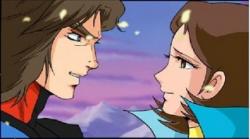|
|
|
HIKARU MAKIBA: THE ROLE RE-ASSESSMENT (EP49-61)
Maria-Grace Fleed appeared on TV screens on 5th September 1976 to Japanese boys’ delight, who immediately celebrated the event letting the show gaining a decent viewers rate level again (by the way, interestingly a sudden peak happened also in ep47*... just when Koji Kabuto had the stage light for himself once in a while...).
 
And the rate increase curve continued for a while, until it stabilised at the same level around ep54. As shop owners usually say, “the customer is always right”... The show has been saved by the Princess of Fleed, no matter how mad the scriptwriter could have become to give a sort of internal coherency to the plots; anyway, after all, considering the difficult conditions where they find themselves acting, the final result was not a disaster. In particular, Maria Grace Fleed allowed the scriptwriters to enjoy a new development phase for the previous characters. Maria Grace’s arrival meant also the famous change of the anime's character designer (from Komatsubara to Araki): but, plus interestingly, the sudden comeback of Shozo Uheara in the writing team (he had left the anime after ep34).
MARIA VS HIKARU
The switch of the focus between the two female characters meant, of course, the virtual “disappearing” of Hikaru in the background: it was the necessary price to pay towards the Japanese boys who hated her to all extent, in order to keep alive the anime. I find amazing that Japanese boys (but as a matter of fact this consideration can be applied also to a big part of western male viewers) disliked so much Hikaru and loved instead Maria Grace with such a passion, despite the fact that the princess of Fleed had apparently a “strong personality” just as Hikaru. The issue Japanese boys had with Hikaru was in fact not centred around her beauty at all, but on the fact she was presented as a revolutionary character of a woman very distant from the classical female social role in Japan. But Maria Grace had more or less the same characteristic, after all, so why loving the princess and hating the girl from the countryside? Nice question, right?  Well, may I try an answer by myself? Is it possible that guys loved (well, actually loves) Maria Grace because she is an alien, so, unconsciously, she is “allowed” to act in such ways without scaring males, while instead a “normal” earthling girl causes irrational fear doing the same things? Sigmund Freud, analyse this.... Well, may I try an answer by myself? Is it possible that guys loved (well, actually loves) Maria Grace because she is an alien, so, unconsciously, she is “allowed” to act in such ways without scaring males, while instead a “normal” earthling girl causes irrational fear doing the same things? Sigmund Freud, analyse this....  1 1
...OR HIKARU FOREVER?
Anyway, a convenient plot to justify the virtual “disappear” of Hikaru in the background should be found and communicated to the viewers. But surprisingly nothing similar happens. The writers simply let Hikaru decreases her appearances in the episodes – even cancelling her completely in ep57 – for a certain time, at least up to the moment Katsuta and Nagai maybe felt confident enough towards the viewer ratings to launch the “final arc”. Anyway, Hikaru’s personality, apparently, seems to suffer of a big transformation, becoming exactly what the Japanese boys and literature schemes wanted her to be: a quiet, ordinary Japanese yes-girl often in danger needing for salvation from the hero from time to time. But is it really true? Or are we facing instead a new masquerade, a renovated tricky storytelling approach to let us know something different once scratched the surface?
Well, I believe that the trick is the correct answer. I think we own enough evidences to be quiet sure that Nagai and Katsuta loved the Hikaru character they have developed up to ep48; I find hard to believe that they would have given the lie to themselves completely only to give satisfaction to the audience. If they really liked to give the viewers what the boys wanted, they would have removed her from the story or sent her back to the farm. The fact that instead she is simply put in the background with the same role in the storyline make me suppose that the Authors did not want to change her personality, but to avoid further problems with the audience applied a new masquerade to the storytelling, in order to hide how much important her character was in the anime. Well, the opening system of the matrioska has become a little more complicated, but with a bit of patience I think it’s possible to succeed.
------------------------------------------------------
1 (Joe7's note) Could I risk another hypothesis? More than for male chauvinist motives (if so, the kids would not even accept Maria Grace as a pilot), I think it's because the idea of people who drives giant machines and robots, and saves people's lives, must be, in the eyes of everyone, a being above the human being, very beautiful and strong: Daisuke, of course, then Maria Grace, who was beautifully made, then Koji Kabuto, who was the hero driving Mazinga Z. In short, "super human beings", to whom a common girl like Hikaru should not even be worthy to belong. The first appearance of Maria Grace in the anime also emphasizes her exceptionality: she is a great motorcyclist who beats three motorcycle riders and she appears on a motorcycle with an adherent jacket and boots that emphasize her shapes before sunset: a tribute, perhaps, to Fujiko Mine of Lupin III, a "particular" woman.
 
  
The fact that it was just the ordinary and common Venusia, instead, to save the situation, often made upset everyone, men and women. Yes, even women: often Daisuke, seen as the "perfect man", is also imagined by women always with the "perfect women" of the series: Naida, Rubina, Mineo, Shira, or other "perfect women" invented by them. Rarely Daisuke was represented along with Hikaru. With the due exceptions, but the general trend is this.
  
Edited by joe 7 - 21/11/2019, 21:47
|
|


 Well, may I try an answer by myself? Is it possible that guys loved (well, actually loves) Maria Grace because she is an alien, so, unconsciously, she is “allowed” to act in such ways without scaring males, while instead a “normal” earthling girl causes irrational fear doing the same things? Sigmund Freud, analyse this....
Well, may I try an answer by myself? Is it possible that guys loved (well, actually loves) Maria Grace because she is an alien, so, unconsciously, she is “allowed” to act in such ways without scaring males, while instead a “normal” earthling girl causes irrational fear doing the same things? Sigmund Freud, analyse this....  1
1











 Contacts
Contacts Web
Web